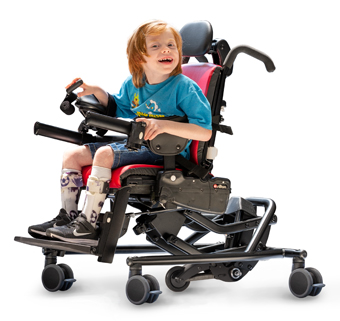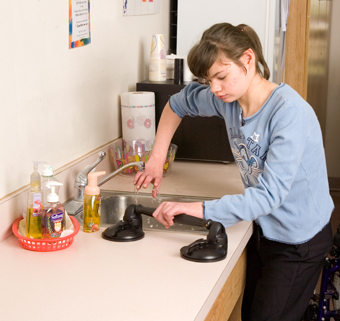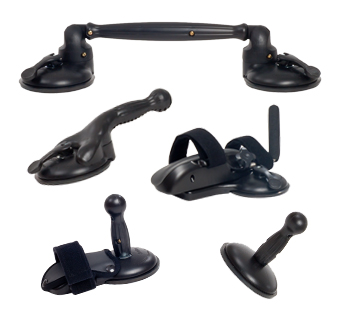Sample Letter of Medical Necessity for a Rifton Feeding Chair
A real letter of medical necessity (edited for HIPAA compliance) written by an OT
| November 2011The following letter was instrumental in gaining funding for a Rifton Activity Chair to be used for feeding purposes.We wanted to share this letter with you in case it can inspire and give you guidance on writing a similar letter of medical necessity for your client.
(Back to Feeding Equipment for Special Needs Children by Ann Walsh, MS/CF-SLP)
Patient Name:
Medical Record Number:
Date of Birth:
Chronological Age:
Date of Evaluation:
Date of Report:
Author:
Primary Care Physician:
Ordering Provider:
Primary Diagnosis:
Secondary Diagnosis:
History and Client/Parental Concerns:
• Introduce child, diagnosis, and pertinent PMH: Timothy is a 5 year old male with diagnosis of multifocal demyelinating peripheral polyneuropathy, hypotonia, possible genetic disorder, and profound sensorineural hearing loss (85%). He has a history of G-tube and Nissen placement after birth, tubes in ears last year.
• Include name(s) of physician(s) and disciplines involved in child’s care: Timothy is followed by Doctor X, Anytown Pediatric Clinic and specialists including a pulmonologist and geneticist. He receives Speech Therapy and Occupation Therapy at Children’s Hospital. Timothy has attended the Feeding Program at Anytown Pediatric Center starting 8/22/10.
• List and describe equipment child uses: Rifton Pacer Gait Trainer; wheelchair – uses at school; AFOs wears 3-4 hours per day (orthotist in Anytown); hearing aids; glasses (which he does not tolerate well); bathchair; Convaid adaptive stroller; and TheraTogs.
• Describe intent of LOMN: Present for evaluation for a feeding seat.
Vendor Information:
Therapy LMN Evaluation Results:
Give a picture of the child’s current physical function describing the deficits that pertain to the medical necessity of a Rifton Activity Chair
Contractures:
Non Present
Strength/Motor Control:
Timothy presents with decreased strength and tone throughout. He demonstrates delayed initiation of and has difficulty maintaining muscle contractions.
Sitting Balance:
Poor, in tailor sit with decreased trunk strength and sitting endurance. Timothy will fall to the side or backwards unexpectedly at times.
Head Control:
Poor, prefers to extend cervical spine when walking and has been observed to bang head with hands or on surfaces nearby at times. Fair in tailor sit with significant proximal support.
Ambulatory Status:
Timothy is able to ambulate with minimal assistance under arms/around chest. He is able to ambulate in Pacer Gait Trainer with stand-by assist.
Age of Current Equipment: Timothy does not have a feeding chair at this time.
Parent/Caregiver Involvement: Yes/No
Parents were present for evaluation and agree with choice of equipment: Yes
Equipment Requested:
Rifton Activity Chair Seat and adjustable back with a Tilt-in-Space and Hi/Lo Base
Itemize chair and justify need for each accessory:
Activity Chair Hi/Lo Base and Tilt-in-space Seat and Back
Rationale: This chair is necessary to offer Timothy adequate postural control and good positioning during oral feedings. Timothy has a wheelchair, but it does not have recline and tilt-in-space options. He is able to tolerate sitting in his wheelchair, but it maintains him at a fixed height. The Rifton Activity Chair seating system with a tilt-in-space base will allow for varying degrees of recline. Timothy requires more upright seating when working on oral motor exercises and a slight recline with tilt-in-space for feeding. Due to his poor trunk control and poor oral transit he responds best with a moderate tilt backward with head in neutral. Without the tilt option, Timothy utilizes unnecessary energy to maintain trunk and head control limiting his ability to focus on oral motor tasks. The Hi/Lo feature also allows Timothy the option of being positioned at the family table to be present for family meals.
Arm Supports
Rationale: The arm supports are necessary to properly support Timothy’s arms while seated. He has poor trunk control and uses his UE for weight bearing and an improved overall upright posture. Without arm support, there would be increased stress to his shoulder joints by letting his arms hang at his sides.
Headrest, contoured
Rationale: Timothy has poor head control and needs the contoured headrest to support his head and keep it in proper alignment for safe swallowing. Timothy also has poor oral transit and a delayed swallow. Without proper head position he could be at risk for either aspiration or increased anterior spillage.
Lateral Supports
Rationale: Timothy has poor trunk control. The lateral supports are necessary to help maintain a midline trunk position. Timothy has extraneous and poorly controlled movement. When he pulls to the side he falls over and is unable to right himself. Without external support he is unable to maintain neutral position of head, neck and trunk and this impacts his ability to swallow in a safe manner.
Push Handles
Rationale: Push handles are required to utilize the Hi/Lo feature of the chair and to maneuver the chair. Additionally, Timothy’s tube feeding supplies can be hung here while he is getting tube fed. Timothy will pull at his tube feeding if it is within sight or reach.
Tray
Rationale: A tray is medically necessary to provide further support to Timothy’s UEs and improve overall trunk position. Timothy also requires the tray for toy placement. Toys are utilized as part of his therapeutic feeding protocol to provide positive reinforcement for targeted feeding behaviors.
Butterfly Harness
Rationale: The butterfly harness is necessary to help keep Timothy positioned in the chair secondary to decreased trunk control. It provides additional anterior trunk support for improved positioning and as a result improved head control.
Hip Guides
Rationale: Timothy demonstrates extraneous impulsive movement of the trunk and extremities. Even with a secure seatbelt, Timothy has shown the ability to push into extension or off to one side when agitated. The hip guides will provide support to keep his hips centrally aligned in the chair. This is essential for safe swallowing.
Adductors
Rationale: Due to Timothy’s significant low tone, his legs remain in an abducted position while seated. Timothy demonstrates poor proximal control and ability to maintain his legs and hips in a neutral position. Appropriate alignment of the hips is essential for proper trunk control and secondary head and neck control for swallowing.
Leg Prompt
Rationale: Timothy sits with increased abduction and lateral rotation secondary to weakness and increased tone. The leg prompt is necessary to refine Timothy’s thigh position providing improved weight bearing along his femurs.
Sandals and Wedges
Rationale: The sandals and wedges are necessary to properly support Timothy’s feet and ankles while seated in his activity chair. The wedges are necessary to accommodate for his ankle/foot position. Proper foot position allows for improved pressure distribution decreasing the chance of breakdown.
Backrest Filler Pad
Rationale: The backrest filler pad is required to fill the space between the bottom of the backrest and seat as the backrest is raised for growth in the chair. Timothy will require full contact back support due to his low tone and poor proximal control.
Therapist’s signature




